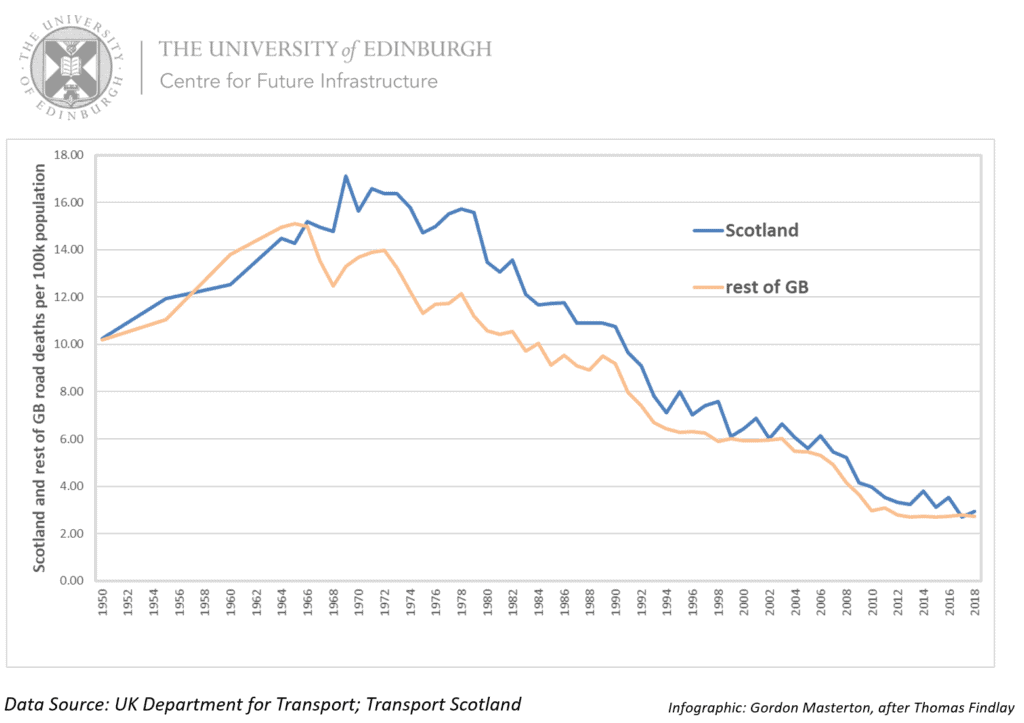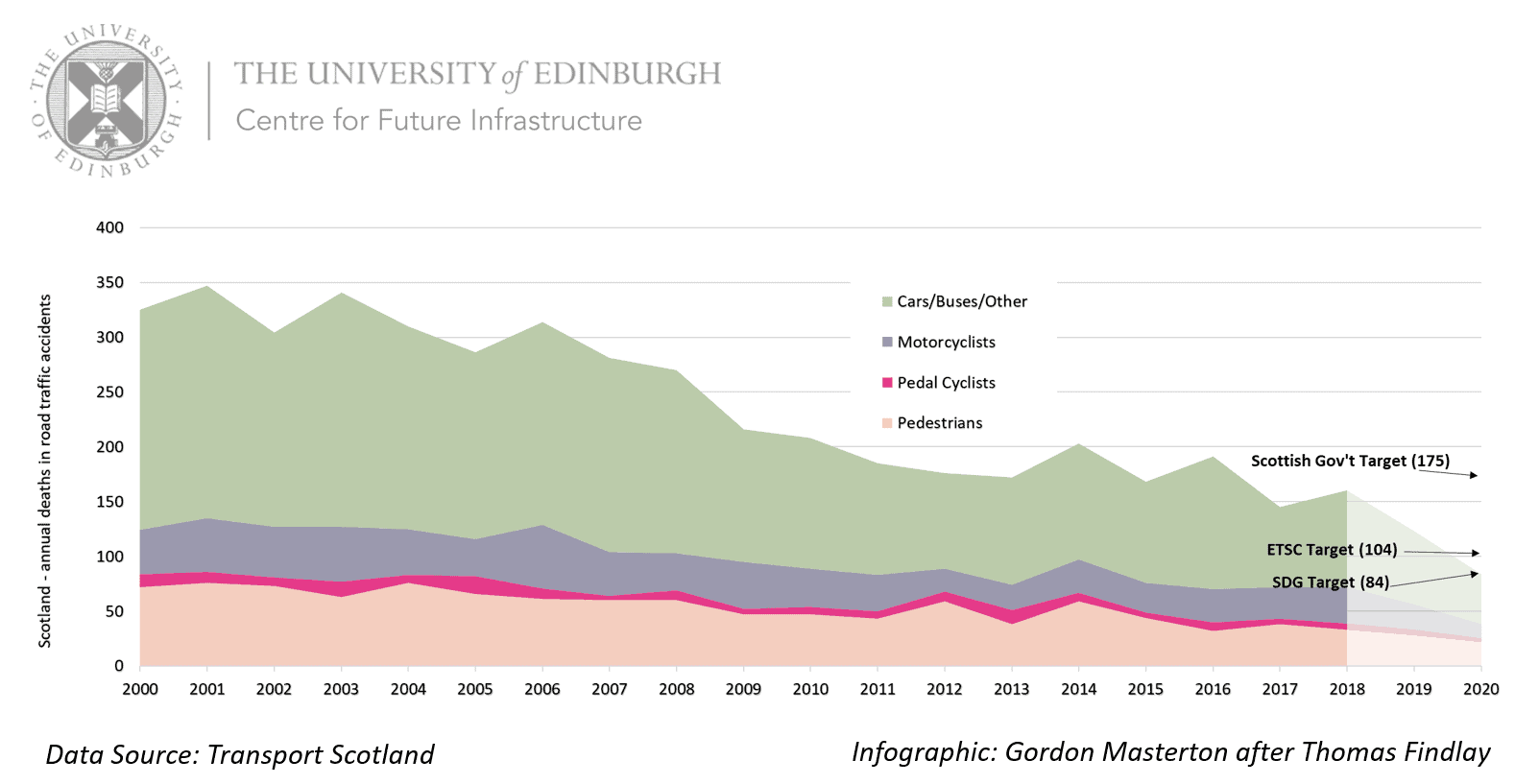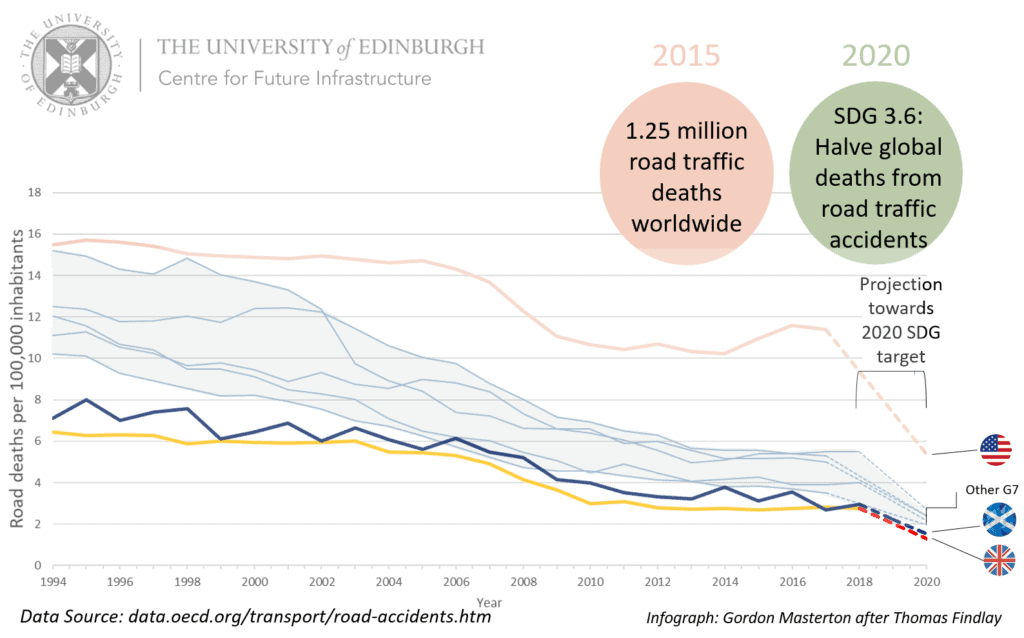A briefing note from the Centre for Future Infrastructure in November 2019 [1] reviewed how the UK was performing against Sustainable Development Goal (SDG) target 3.6 – to halve road fatalities between 2015 and 2020.
This briefing note provides an update on how Scotland is doing. A 2018 Centre for Future Infrastructure Briefing Note provides additional context [2].
Fig 1 plots road death rates per 100,000 population for both Scotland and the rest of Great Britain since 1950.

Figure 1: Scotland and rest of GB road accident deaths per 100,000 population 1950-2018
There has been an increase in road deaths from 2017 although 2018 is the second-best year on record and the year-on-year variation is within typical historic bands. The good news is that the probability of a Scottish resident being killed in a road traffic accident today is 1/6 of what it was in 1969, despite there being 2.7 times more licensed vehicles on the roads [3]. The population-related death rate is slightly behind the rest of GB. Year on year data in a relatively small dataset is by no means a reliable basis for forecasting, but the underlying trend does not appear to have plateaued to the same extent as the rest of GB.
In 2018 there were160 fatalities on Scottish roads, the second lowest ever and still significantly less than the Scottish Government’s target set in 2009 (to reduce deaths in 2020 by 40% from the 2004-08 average [4]).
Let’s look more closely at recent years and return to the number of deaths, being the chosen SDG metric.
Fig 2 shows Scotland’s road deaths since 2000 and looks forward to 2020 to show where we need to get to for the SDG target. Hitting the SDG target of 84 deaths by 2020 now looks very challenging.

Figure 2: Scotland – annual road traffic accident deaths 2000-17 and targets for 2020
The European Union agreed a target of reducing road deaths by 50% from 2010 levels by 2020[5]. This European Traffic Safety Council (ETSC) target has also been added to Fig 2. It is less stretching than the SDG Target but more ambitious than the Scottish Government target.
Transport Scotland’s 2016 Strategic Road Safety Plan maintains the less ambitious target set in 2009, with no acknowledgement yet of either the EU or the SDG Targets [6].
How is Scotland benchmarked against its peers? Scotland’s road safety death rate (by population), is better than most G7 countries (Fig 3) and after many years lagging, now tracks UK data more closely.

Figure 3: Scotland and G7 Countries – road death rates since 1994 and projections to SDG Target
Is there any realistic prospect of hitting the SDG target, or even the ETSC target? Last year we said: “Perhaps, but only with a strong commitment to succeed and a recognition of the social and economic importance of reducing avoidable deaths on a large scale, which in turn requires inspired leadership from industry and policy-makers[7].”
The EU target of halving deaths every decade rather than the SDG target of five years has a greater depth of academic and social research behind it and is self-evidently more achievable[8]. Even that would now be a stretchy target for Scotland by 2020, although not impossible.
In Scotland in 2018, for every reported death, 52 people were injured, with 10 of those being serious and 45% of people who died in road accidents were vulnerable road users (pedestrians, cyclists or motorcyclists). If 160 people died in a single incident, each and every year, there would be a national outcry over the avoidable loss.
The average cost of a road safety fatality in the UK has been reported as £2.2m and total prevention costs from reported road accidents amounted to £16.5bn in 2018 [9]. Using these estimates, the failure to reduce road traffic deaths and injuries by 15% each year since 2015 has already cost Scotland some £0.5bn between 2016 and 2018 (the delta between the actual and targeted reduction) and if trends continue, will have cost Scotland £1.5bn by 2020.
Without taking away from what remains an impressive track record in reducing road accident deaths since 1970, the value to the Scottish public purse of investing a fraction of that avoidable cost into technology improvements, more intensive policing, public advertising campaigns, research into root causes of fatalities, under impassioned and focussed leadership would have a very good chance of yielding a healthy return.
Arguably, moral and ethical principles and setting a global example should demand that we do it anyway.
Footnotes
[1] Road Safety – the UK’s Stalled Progress towards Global Goal Target 3.6. Infrastructure Global Goals Briefing Note 1. Centre for Future Infrastructure, University of Edinburgh, November 2019.
[2] Road Safety – should Scotland adopt Sustainable Development Goal target 3.6? Global Goals Briefing Note 2. Centre for Future Infrastructure, University of Edinburgh, August 2018.
[3] https://www.transport.gov.scot/publication/key-reported-road-casualties-scotland-2018/
[4]Go Safe on Scotland’s Roads it’s Everyone’s Responsibility: Scotland’s Road Safety Framework to 2020. 2009.
[5] 11th Road Safety Performance Index (PIN) Report. European Transport Safety Council. 2017.
[6]Strategic Road Safety Plan 2016. Transport Scotland. ISBN: 978-1-909948-74-7
[7] Road Safety – A Sustainable Development Own Goal for the UK? Infrastructure Global Goals Briefing Note 1. Centre for Future Infrastructure, University of Edinburgh, January 2018
[8] Reducing Risk on Road and Rail. Richard Allsop. UTSG50: Universities Transport Study Group Conference. UCL London. January 2018.
[9] Average cost of road accidents in Great Britain 2018, by severity. N. Sönnichsen statista.com. Oct 18, 2019.
Prof Gordon Masterton
Centre for Future Infrastructure, Edinburgh Futures Institute, The University of Edinburgh. 2019.





